Investigation of the Shadow Effect in Focused Ion Beam Induced Deposition
Abstract
:1. Introduction
2. Materials and Methods
2.1. Experimental Materials and Methods
2.2. Simulation Methods
2.2.1. The CCA Model
2.2.2. The EPMDM Model
2.2.3. The Shadow Area Defining Model
2.2.4. The Precursor Gas Flow Model
3. Results and Discussion
3.1. Experimental Results
3.1.1. Pillars with Different Distances from the Shading Structure
3.1.2. Time-Dependent Variation in Heights and Growth Rates of Pillars Grown within the Shadow Area
3.1.3. The Influence of the Shading Structure’s Morphology on the Shadow Effect
3.2. Simulation Results
3.2.1. Calculation of the Shading Length and Boundary Height
3.2.2. Calculation of the δ Distribution within the Shadow Area
3.2.3. Calculation of Precursor Gas Concentration and Pillar Height
4. Conclusions
Supplementary Materials
Author Contributions
Funding
Data Availability Statement
Conflicts of Interest
References
- Hinum-Wagner, J.; Kuhness, D.; Kothleitner, G.; Winkler, R.; Plank, H. FEBID 3D-Nanoprinting at Low Substrate Temperatures: Pushing the Speed While Keeping the Quality. Nanomaterials 2021, 11, 1527. [Google Scholar] [CrossRef] [PubMed]
- Sanz-Martin, C.; Magen, C.; De Teresa, J.M. High Volume-Per-Dose and Low Resistivity of Cobalt Nanowires Grown by Ga(+) Focused Ion Beam Induced Deposition. Nanomaterials 2019, 9, 1715. [Google Scholar] [CrossRef] [PubMed] [Green Version]
- Utke, I.; Michler, J.; Winkler, R.; Plank, H. Mechanical Properties of 3D Nanostructures Obtained by Focused Electron/Ion Beam-Induced Deposition: A Review. Micromachines 2020, 11, 397. [Google Scholar] [CrossRef] [PubMed] [Green Version]
- Skoric, L.; Sanz-Hernandez, D.; Meng, F.; Donnelly, C.; Merino-Aceituno, S.; Fernandez-Pacheco, A. Layer-by-Layer Growth of Complex-Shaped Three-Dimensional Nanostructures with Focused Electron Beams. Nano Lett. 2020, 20, 184–191. [Google Scholar] [CrossRef] [PubMed]
- Belianinov, A.; Burch, M.J.; Ievlev, A.; Kim, S.; Stanford, M.G.; Mahady, K.; Lewis, B.B.; Fowlkes, J.D.; Rack, P.D.; Ovchinnikova, O.S. Direct Write of 3D Nanoscale Mesh Objects with Platinum Precursor via Focused Helium Ion Beam Induced Deposition. Micromachines 2020, 11, 527. [Google Scholar] [CrossRef] [PubMed]
- Li, P.; Chen, S.; Dai, H.; Yang, Z.; Chen, Z.; Wang, Y.; Chen, Y.; Peng, W.; Shan, W.; Duan, H. Recent advances in focused ion beam nanofabrication for nanostructures and devices: Fundamentals and applications. Nanoscale 2021, 13, 1529–1565. [Google Scholar] [CrossRef]
- Blom, T.J.; Mechielsen, T.W.; Fermin, R.; Hesselberth, M.B.S.; Aarts, J.; Lahabi, K. Direct-Write Printing of Josephson Junctions in a Scanning Electron Microscope. ACS Nano 2021, 15, 322–329. [Google Scholar] [CrossRef]
- Cordoba, R.; Ibarra, A.; Mailly, D.; De Teresa, J.M. Vertical Growth of Superconducting Crystalline Hollow Nanowires by He(+) Focused Ion Beam Induced Deposition. Nano Lett. 2018, 18, 1379–1386. [Google Scholar] [CrossRef] [Green Version]
- Cordoba, R.; Mailly, D.; Rezaev, R.O.; Smirnova, E.I.; Schmidt, O.G.; Fomin, V.M.; Zeitler, U.; Guillamon, I.; Suderow, H.; De Teresa, J.M. Three-Dimensional Superconducting Nanohelices Grown by He(+)-Focused-Ion-Beam Direct Writing. Nano Lett. 2019, 19, 8597–8604. [Google Scholar] [CrossRef] [Green Version]
- Esposito, M.; Tasco, V.; Todisco, F.; Cuscuna, M.; Benedetti, A.; Sanvitto, D.; Passaseo, A. Triple-helical nanowires by tomographic rotatory growth for chiral photonics. Nat. Commun. 2015, 6, 6484. [Google Scholar] [CrossRef] [Green Version]
- Esposito, M.; Tasco, V.; Todisco, F.; Benedetti, A.; Tarantini, I.; Cuscuna, M.; Dominici, L.; De Giorgi, M.; Passaseo, A. Tailoring chiro-optical effects by helical nanowire arrangement. Nanoscale 2015, 7, 18081–18088. [Google Scholar] [CrossRef] [PubMed]
- Wang, M.; Salut, R.; Suarez, M.A.; Martin, N.; Grosjean, T. Chiroptical transmission through a plasmonic helical traveling-wave nanoantenna, towards on-tip chiroptical probes. Opt. Lett. 2019, 44, 4861–4864. [Google Scholar] [CrossRef] [PubMed]
- Fowlkes, J.D.; Winkler, R.; Lewis, B.B.; Stanford, M.G.; Plank, H.; Rack, P.D. Simulation-Guided 3D Nanomanufacturing via Focused Electron Beam Induced Deposition. ACS Nano 2016, 10, 6163–6172. [Google Scholar] [CrossRef]
- Utke, I.; Hoffmann, P.; Melngailis, J. Gas-assisted focused electron beam and ion beam processing and fabrication. J. Vac. Sci. Technol. B Microelectron. Nanometer Struct. 2008, 26, 1197. [Google Scholar] [CrossRef] [Green Version]
- Fang, C.; Xing, Y.; Zhou, Z.; Chai, Q.; Chen, Q. Structural characterization and continuous cellular automata simulation of micro structures by focused Ga ion beam induced deposition process. Sens. Actuators A Phys. 2020, 312, 112150. [Google Scholar] [CrossRef]
- Plank, H.; Gspan, C.; Dienstleder, M.; Kothleitner, G.; Hofer, F. The influence of beam defocus on volume growth rates for electron beam induced platinum deposition. Nanotechnology 2008, 19, 485302. [Google Scholar] [CrossRef]
- Kim, C.-S.; Ahn, S.-H.; Jang, D.-Y. Review: Developments in micro/nanoscale fabrication by focused ion beams. Vacuum 2012, 86, 1014–1035. [Google Scholar] [CrossRef]
- Smith, D.A.; Fowlkes, J.D.; Rack, P.D. A nanoscale three-dimensional Monte Carlo simulation of electron-beam-induced deposition with gas dynamics. Nanotechnology 2007, 18, 265308. [Google Scholar] [CrossRef]
- Smith, D.A.; Fowlkes, J.D.; Rack, P.D. Simulating the effects of surface diffusion on electron beam induced deposition via a three-dimensional Monte Carlo simulation. Nanotechnology 2008, 19, 415704. [Google Scholar] [CrossRef]
- Fang, C.; Chai, Q.; Chen, Q.; Xing, Y. Continuous cellular automaton simulation of focused ion beam-induced deposition for nano structures. Nanotechnology 2019, 31, 105301. [Google Scholar] [CrossRef]
- Utke, I.; Friedli, V.; Amorosi, S.; Michler, J.; Hoffmann, P. Measurement and simulation of impinging precursor molecule distribution in focused particle beam deposition/etch systems. Microelectron. Eng. 2006, 83, 1499–1502. [Google Scholar] [CrossRef]
- Friedli, V.; Utke, I. Optimized molecule supply from nozzle-based gas injection systems for focused electron- and ion-beam induced deposition and etching: Simulation and experiment. J. Phys. D Appl. Phys. 2009, 42, 125305. [Google Scholar] [CrossRef]
- Li, W.; Warburton, P.A. Low-current focused-ion-beam induced deposition of three-dimensional tungsten nanoscale conductors. Nanotechnology 2007, 18, 485305. [Google Scholar] [CrossRef]
- Keller, L.; Huth, M. Pattern generation for direct-write three-dimensional nanoscale structures via focused electron beam induced deposition. Beilstein J. Nanotechnol. 2018, 9, 2581–2598. [Google Scholar] [CrossRef]
- Winkler, R.; Fowlkes, J.; Szkudlarek, A.; Utke, I.; Rack, P.D.; Plank, H. The nanoscale implications of a molecular gas beam during electron beam induced deposition. ACS Appl. Mater. Interfaces 2014, 6, 2987–2995. [Google Scholar] [CrossRef]
- Szkudlarek, A.; Szmyt, W.; Kapusta, C.; Utke, I. Lateral resolution in focused electron beam-induced deposition: Scaling laws for pulsed and static exposure. Appl. Phys. A 2014, 117, 1715–1726. [Google Scholar] [CrossRef] [Green Version]
- Utke, I.; Friedli, V.; Purrucker, M.; Michler, J. Resolution in focused electron- and ion-beam induced processing. J. Vac. Sci. Technol. B Microelectron. Nanometer Struct. 2007, 25, 2219–2223. [Google Scholar] [CrossRef] [Green Version]
- Zhang, S.; Gervinskas, G.; Liu, Y.; Marceau, R.K.W.; Fu, J. Nanoscale coating on tip geometry by cryogenic focused ion beam deposition. Appl. Surf. Sci. 2021, 564, 150355. [Google Scholar] [CrossRef]
- Lei, Y.; Jiang, J.; Wang, Y.; Bi, T.; Zhang, L. Structure evolution and stress transition in diamond-like carbon films by glancing angle deposition. Appl. Surf. Sci. 2019, 479, 12–19. [Google Scholar] [CrossRef]
- Fang, C.; Chai, Q.; Lin, X.; Xing, Y.; Zhou, Z. Experiments and simulation of the secondary effect during focused Ga ion beam induced deposition of adjacent nanostructures. Mater. Des. 2021, 209, 109993. [Google Scholar] [CrossRef]
- Morita, T.; Kometani, R.; Watanabe, K.; Kanda, K.; Haruyama, Y.; Hoshino, T.; Kondo, K.; Kaito, T.; Ichihashi, T.; Matsui, S.; et al. Free-space-wiring fabrication in nano-space by focused-ion-beam chemical vapor deposition. J. Vac. Sci. Technol. B Microelectron. Nanometer Struct. 2003, 21, 2732. [Google Scholar] [CrossRef]
- Chen, P.; Salemink, H.W.M.; Alkemade, P.F.A. Roles of secondary electrons and sputtered atoms in ion-beam-induced deposition. J. Vac. Sci. Technol. B Microelectron. Nanometer Struct. 2009, 27, 2718. [Google Scholar] [CrossRef] [Green Version]
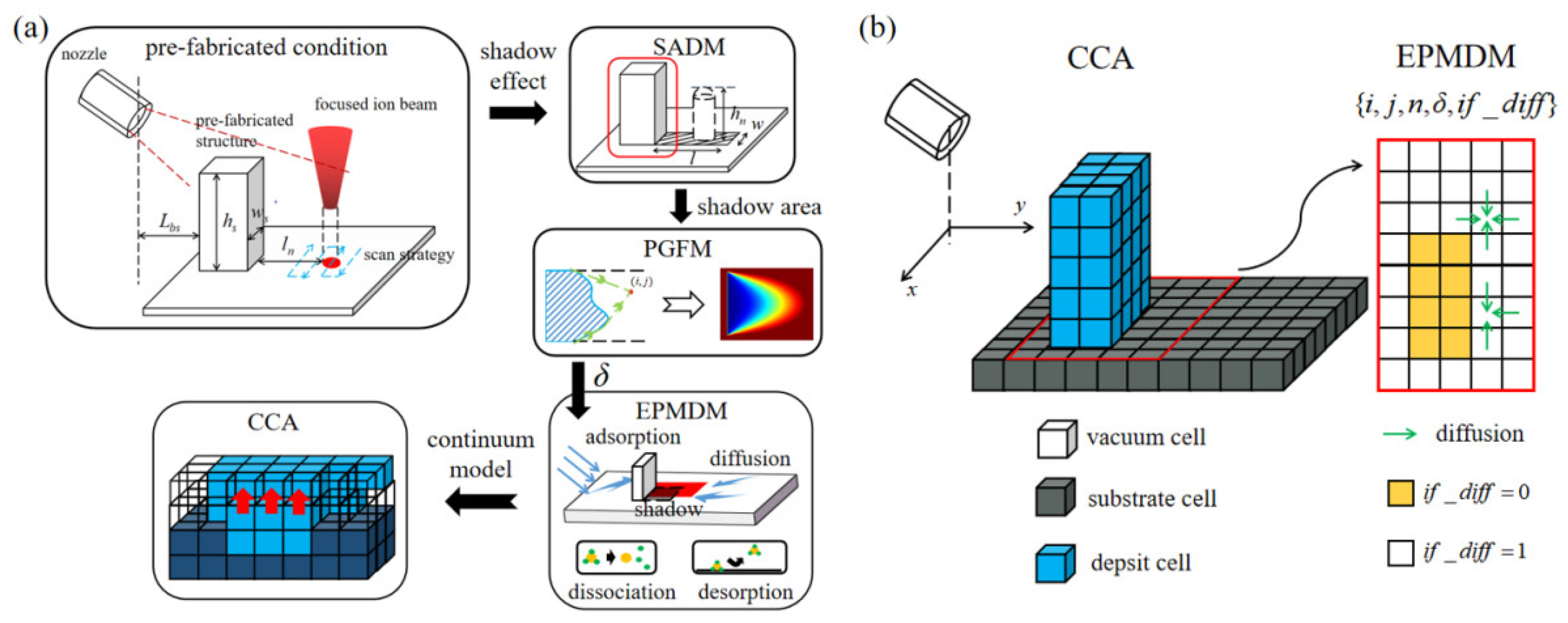
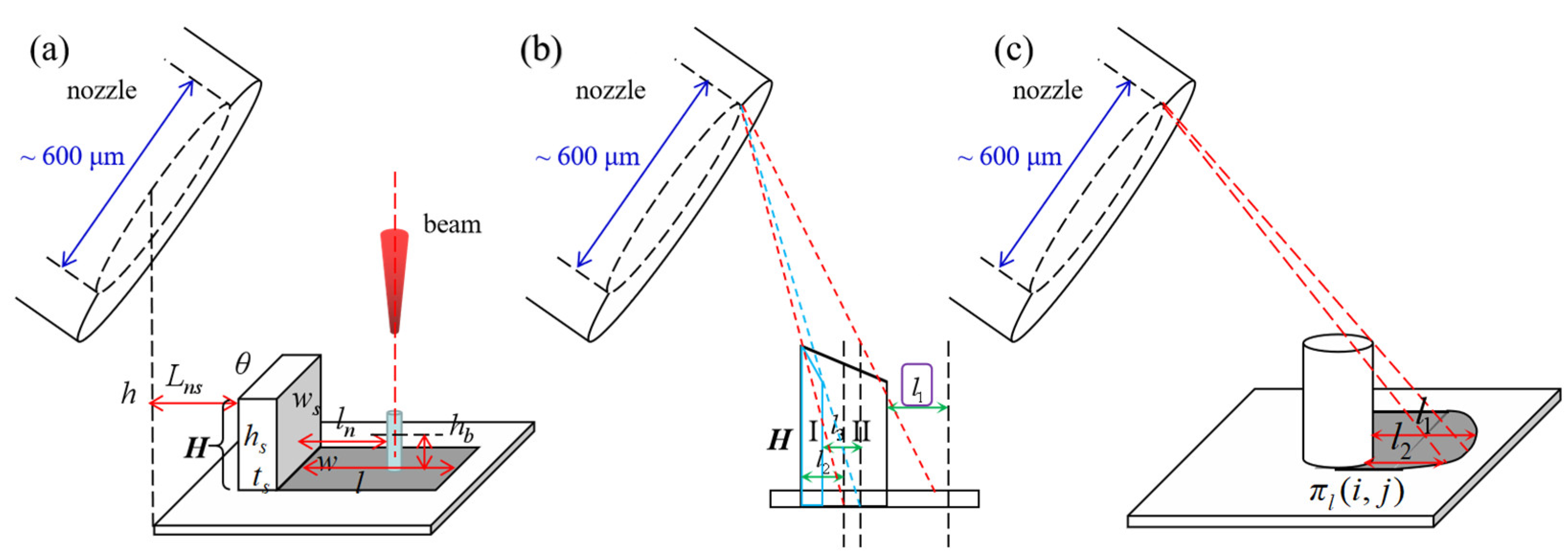
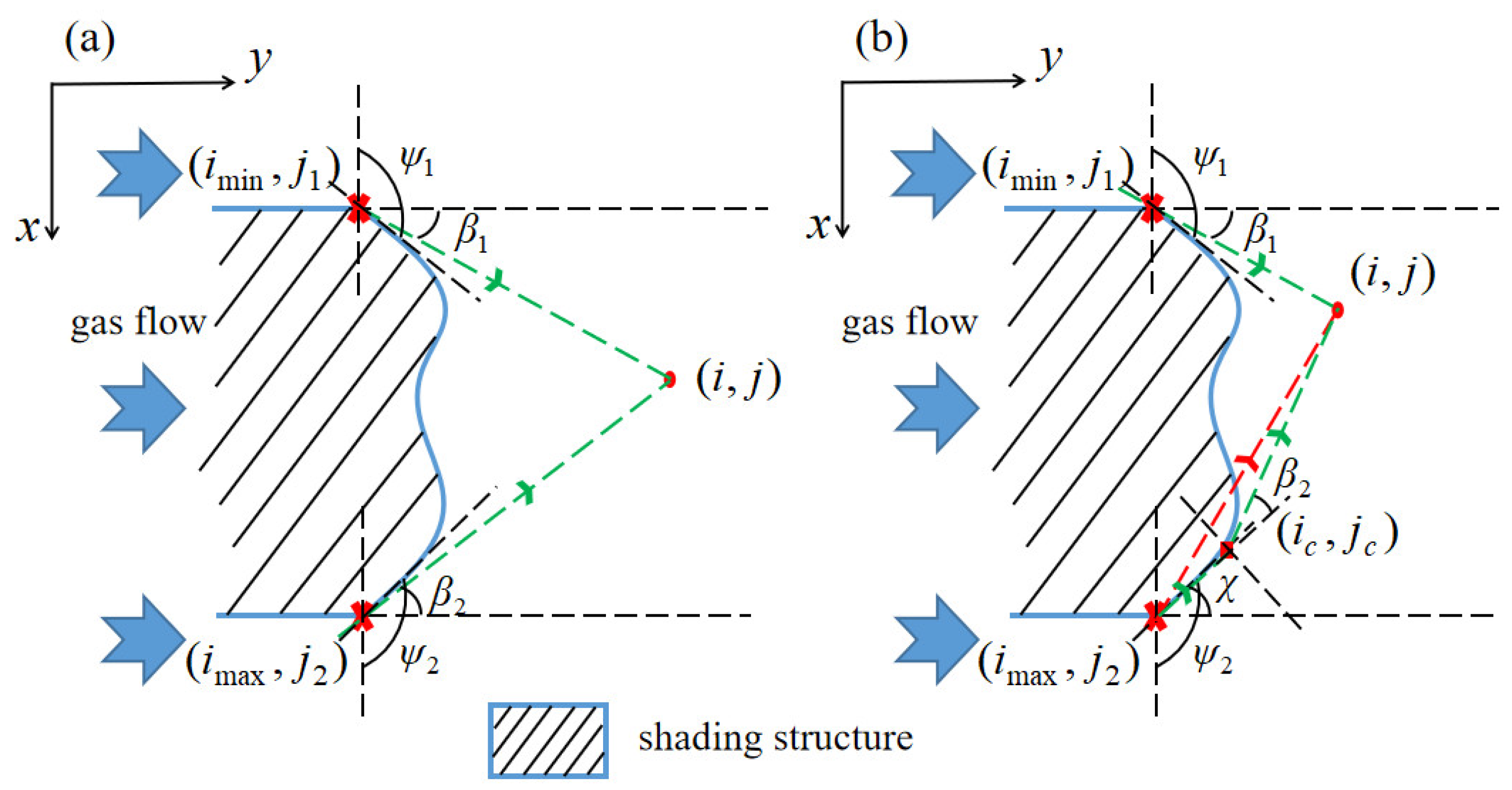

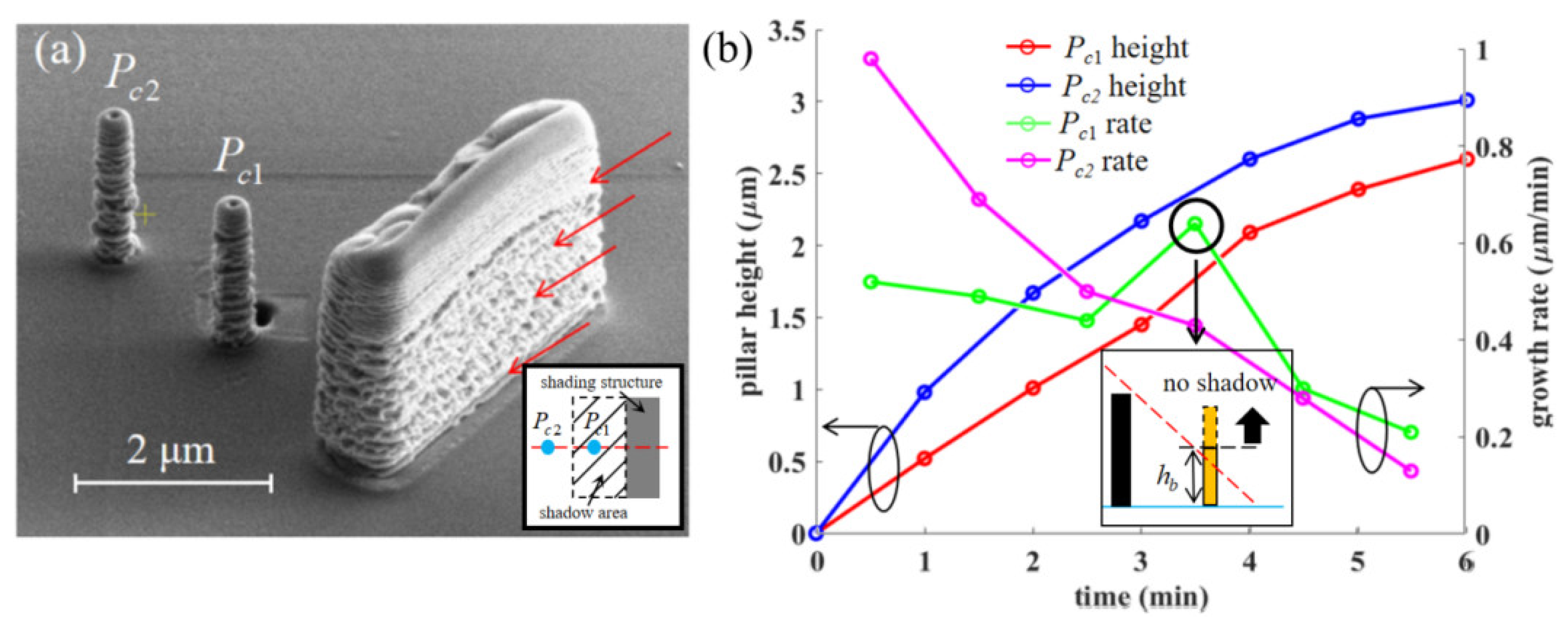


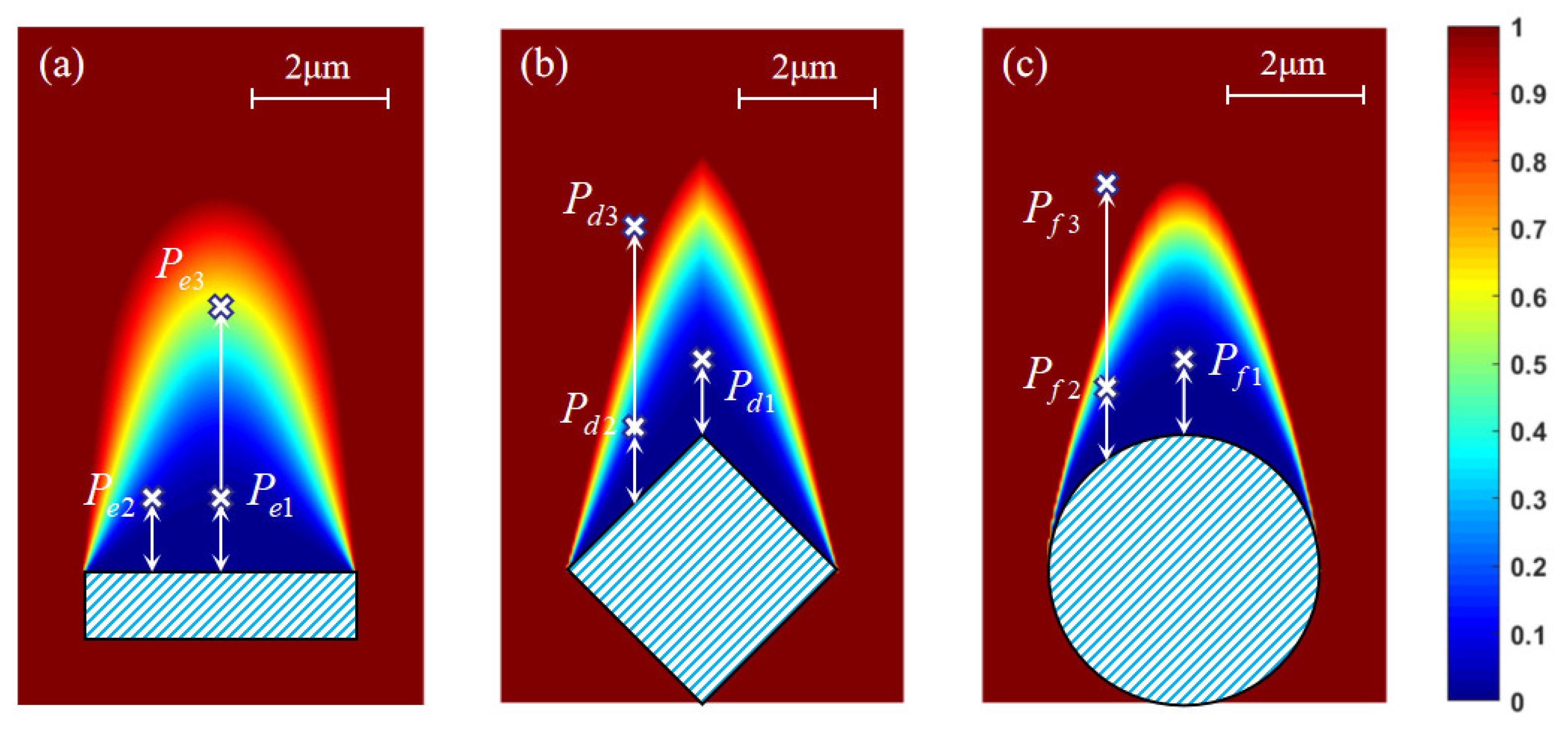

Publisher’s Note: MDPI stays neutral with regard to jurisdictional claims in published maps and institutional affiliations. |
© 2022 by the authors. Licensee MDPI, Basel, Switzerland. This article is an open access article distributed under the terms and conditions of the Creative Commons Attribution (CC BY) license (https://creativecommons.org/licenses/by/4.0/).
Share and Cite
Fang, C.; Xing, Y. Investigation of the Shadow Effect in Focused Ion Beam Induced Deposition. Nanomaterials 2022, 12, 905. https://doi.org/10.3390/nano12060905
Fang C, Xing Y. Investigation of the Shadow Effect in Focused Ion Beam Induced Deposition. Nanomaterials. 2022; 12(6):905. https://doi.org/10.3390/nano12060905
Chicago/Turabian StyleFang, Chen, and Yan Xing. 2022. "Investigation of the Shadow Effect in Focused Ion Beam Induced Deposition" Nanomaterials 12, no. 6: 905. https://doi.org/10.3390/nano12060905
APA StyleFang, C., & Xing, Y. (2022). Investigation of the Shadow Effect in Focused Ion Beam Induced Deposition. Nanomaterials, 12(6), 905. https://doi.org/10.3390/nano12060905





